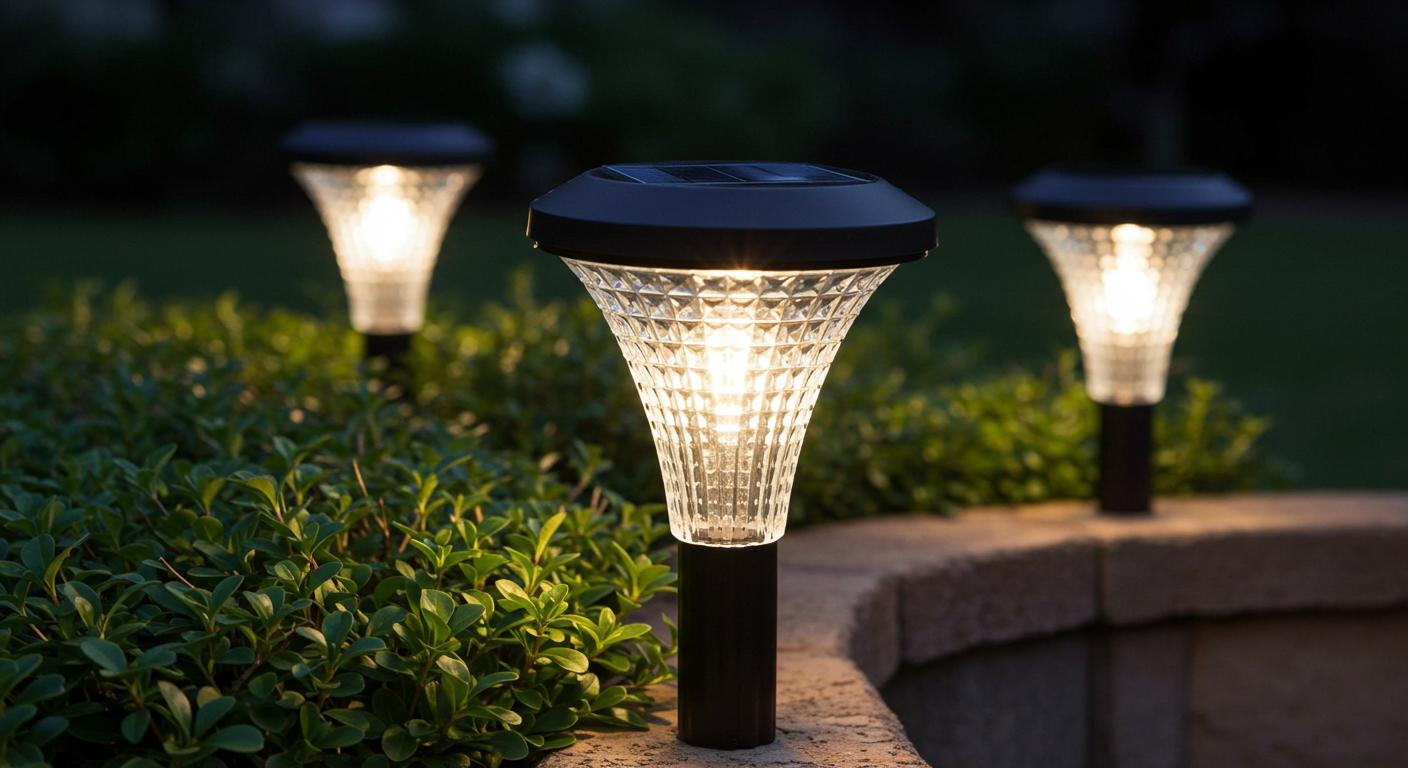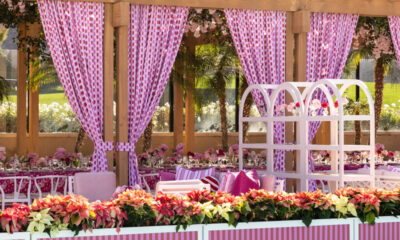Home
Outdoor Solar Lights: Brightening Your Outdoor Spaces with the Power of the Sun

Outdoor solar lights have become a popular choice for illuminating gardens, pathways, and other outdoor spaces. They offer an eco-friendly and cost-effective alternative to traditional electric lighting. This article explores the benefits, types, installation tips, maintenance, and creative uses of outdoor solar lights.
How Outdoor Solar Lights Work
Outdoor solar lights operate on a surprisingly simple principle. Each light contains a small solar panel that converts sunlight into electricity during daylight hours. This electricity charges a battery inside the light. When darkness falls, a sensor detects the lack of light and triggers the light to turn on, using the energy stored in the battery.
Most outdoor solar lights use LED (Light Emitting Diode) bulbs, which are highly efficient and use very little power. This allows the lights to stay on for many hours using just the energy collected during the day. Depending on the model and how much sunlight they receive, outdoor solar lights can provide illumination for anywhere from 8 to 12 hours or more.
Key Components
Solar Panel
Captures sunlight and converts it to electricity through photovoltaic cells.
Battery
Stores the collected energy (usually rechargeable) for use after dark.
Light Sensor
Detects when it’s dark enough to turn on the light automatically.
LED Bulbs
Provide the actual light output using minimal energy.
Housing
Protects all components from weather and provides the aesthetic design.
One of the best things about outdoor solar lights is their completely wireless operation. Since they generate and store their own power, you don’t need to connect them to your home’s electrical system. This makes installation as simple as placing the light where you want it – no digging, wiring, or hiring an electrician required!
Benefits of Choosing Outdoor Solar Lights
Energy Savings
Perhaps the most obvious advantage of outdoor solar lights is that they use free energy from the sun. Once you’ve purchased the lights, there are no ongoing electricity costs. This can lead to significant savings, especially if you’re lighting a large area or using multiple lights.
Environmental Advantages
Zero Emissions
Outdoor solar lights produce no carbon emissions during operation. By choosing solar over traditional electric lights, you’re reducing your carbon footprint and helping to combat climate change. They’re a perfect choice for environmentally conscious homeowners.
Reduced Resource Use
Solar lighting reduces demand on the electrical grid and the resources needed to generate that electricity.
Installation Benefits
No Wiring Required
As mentioned earlier, outdoor solar lights don’t require any wiring. This makes them incredibly easy to install – simply place them where they’ll receive good sunlight during the day. There’s no need to hire an electrician or worry about finding outdoor electrical outlets.
DIY-Friendly
Almost anyone can install outdoor solar lights without special tools or skills.
Maintenance Considerations
Low Upkeep
Modern outdoor solar lights are designed to be very low maintenance. The LED bulbs typically last for many years, and the rechargeable batteries can usually go several years before needing replacement. Most solar lights are also weather-resistant and can withstand rain, snow, and heat.
Simple Cleaning
Occasional cleaning of the solar panel is usually all that’s required to maintain performance.
Practical Advantages
Flexibility and Portability
Since they don’t need to be connected to an electrical supply, outdoor solar lights can be placed virtually anywhere that receives sunlight. This gives you complete flexibility in your outdoor lighting design. You can also easily move them if you decide to change your garden layout or if you move to a new home.
Safety Features
With no electrical wiring required, outdoor solar lights eliminate the risk of electric shocks. This makes them particularly safe for homes with children or pets. They’re also safe to use near water features, pools, or in areas that flood occasionally.
Automatic Operation
Most outdoor solar lights have built-in sensors that automatically turn them on at dusk and off at dawn. This means you don’t have to remember to switch them on and off, making them a convenient “set and forget” lighting solution.
Installation Locations
Solar wall lights are mounted on vertical surfaces like fences, siding, or garden walls. They’re great for illuminating entryways, patios, decks, and other areas adjacent to structures.
Specialized Uses
Some models are designed specifically for illuminating house numbers or mailboxes, making your home easier to find at night.
Design Varieties
These come in numerous styles from modern to traditional to match your home’s exterior.
Decorative and Accent Lighting
String Lights
Solar string lights consist of multiple small bulbs connected by a wire, with a solar panel that can be staked into the ground. They’re perfect for creating a festive or cozy atmosphere on patios, decks, pergolas, or wrapped around trees. Solar string lights come in various styles, from classic white to multicolored options and even novelty shapes like stars or flowers.
Lanterns and Figurines
These outdoor solar lights focus more on style and creating ambiance rather than providing functional lighting. They come in countless designs, including lanterns, torches, globes, animal figures, and color-changing models. Decorative solar lights can add personality and charm to your garden or outdoor living areas.
Floating Lights
Designed for ponds, pools, and other water features, floating solar lights add a magical touch to water elements in your landscape. During the day, they charge in the sun while floating on the water’s surface. At night, they create beautiful reflections on the water.
Security Lighting
Motion Detection
Solar security lights are designed with brightness and coverage in mind. They often include motion sensors that trigger brighter illumination when movement is detected. This helps conserve battery power while still providing security benefits.
Brightness and Coverage
These typically offer the highest lumen output among solar lights, sometimes reaching 1000+ lumens.
Additional Features
Some models also include features like alarms or the ability to connect to home security systems.
Factors to Consider When Choosing Outdoor Solar Lights
Light Performance
Brightness Requirements
The brightness of outdoor solar lights is typically measured in lumens. Path lights may offer anywhere from 5 to 100 lumens, while security floodlights might provide 700 lumens or more. Think about what you’re trying to illuminate and how bright you need the light to be. Remember that very bright lights may not be appropriate in all settings, especially in residential neighborhoods where they might shine into neighbors’ windows.
Light Duration
Consider how long you need the lights to stay on each night. Most quality outdoor solar lights will operate for 8-12 hours when fully charged.
Light Color and Temperature
Outdoor solar lights are available in different color temperatures, measured in Kelvins (K). Lower temperatures (2700-3000K) produce a warm, yellowish light similar to traditional incandescent bulbs, creating a cozy, inviting atmosphere. Higher temperatures (5000-6000K) create a cooler, bluish-white light that’s brighter and more similar to daylight. Some decorative models offer color-changing options or specific colors like blue, red, or green for aesthetic purposes.
Environmental Considerations
Sunlight Exposure
For outdoor solar lights to work effectively, their solar panels need good exposure to sunlight. Before purchasing, assess your yard and identify areas that receive at least 6-8 hours of direct sunlight daily. Lights placed in partial shade will still work but may not shine as brightly or for as long.
Panel Adjustability
Some high-end models have separate, adjustable solar panels that can be positioned to catch maximum sunlight even if the light itself needs to be in a shadier spot.
Climate Compatibility
Consider your local climate. Extreme temperatures (both hot and cold) can affect battery performance and longevity.
Construction Quality
Weather Resistance
Since outdoor solar lights will be exposed to the elements year-round, durability is crucial. Look for models with good weather resistance ratings, particularly if you live in an area with extreme weather conditions. Most quality solar lights are designed to be waterproof or at least weather-resistant, but some are more durable than others. Check the IP (Ingress Protection) rating – the higher the number, the better the protection against dust and water.
Material Quality
The materials used in outdoor solar lights affect both their appearance and longevity. Plastic models are typically less expensive but may degrade faster under UV exposure. Metal lights (especially stainless steel, aluminum, or copper) generally last longer and often look more premium, though they come with a higher price tag. Glass components add elegance but may be more fragile.
Battery Capacity
Battery capacity affects how long your lights will shine each night. Lights with larger battery capacities can store more energy and typically provide illumination for longer periods. This is especially important if you live in an area with shorter winter days or frequent cloudy weather. Look for lights with batteries that can hold enough charge to last through the night.
Maintaining Your Outdoor Solar Lights
Regular Care
Panel Cleaning
Dust, dirt, pollen, and bird droppings can accumulate on solar panels, reducing their efficiency. Clean the panels regularly with a soft cloth and mild soapy water. Avoid abrasive cleaners that might scratch the surface. A clean panel can improve charging efficiency by 20-30%.
Winter Maintenance
If you live in a snowy climate, gently brush snow off the solar panels when needed. Even a thin layer of snow can significantly reduce charging capability.
Inspection Schedule
Establish a regular schedule to check that all lights are functioning properly. Spring and fall are good times for a thorough inspection.
Component Maintenance
Battery Care
Most outdoor solar lights use rechargeable batteries that eventually need replacement (typically every 1-3 years, depending on quality). When performance begins to decline (shorter run times or dimmer light), consider replacing the batteries. Most use standard rechargeable AA or AAA batteries that can be purchased at any hardware store.
Housing Inspection
Check for cracks, moisture infiltration, or other damage to the light housing that might allow water to reach electronic components.
Sensor Cleaning
Keep light sensors clean and free from debris that might interfere with their operation.
Seasonal Considerations
Winter Storage
If you live in an area with extreme winters, you might want to store certain types of outdoor solar lights during the harshest months. Before storage, clean them thoroughly, remove the batteries if possible, and store in a dry location.
Spring Repositioning
After winter, reassess the positioning of your lights as foliage growth may create new shade patterns.
Sensor Verification
If your lights aren’t turning on automatically at dusk, the light sensor might be dirty or malfunctioning. Clean around the sensor area and test again. Some lights have a small switch that can be used to override the sensor for testing purposes.
Practical Applications
Emergency Preparedness
Keep a few portable outdoor solar lights accessible for power outages. They can provide emergency lighting both indoors and out when electricity is unavailable.
Address Visibility
Use a small solar spotlight to illuminate your house number at night, making it easier for visitors or emergency services to find your home.
Dark Corner Illumination
Use solar lights to brighten dark corners of your property that might otherwise be safety hazards.
The Future of Outdoor Solar Lighting
Technological Advancements
Increased Efficiency
Newer solar panels can convert more sunlight into electricity, even in less-than-ideal conditions. This means future outdoor solar lights will provide brighter illumination and longer run times, even with smaller panels or during winter months.
Better Batteries
Improvements in battery technology are leading to longer-lasting, more efficient energy storage. This allows outdoor solar lights to stay brighter for longer periods and extends the overall lifespan of the products.
Miniaturization
As technology improves, solar cells and batteries are becoming smaller while maintaining or improving performance.
Smart Technology Integration
Connectivity Features
Expect to see more outdoor solar lights that connect to home automation systems, allowing you to control them via smartphone apps or voice assistants. Some might also collect data on weather patterns to optimize their performance automatically.
Adaptive Programming
Future lights might adjust brightness based on usage patterns, weather forecasts, or even user proximity.
Security Integration
Integration with home security systems will become more sophisticated, with solar lights responding to security conditions.
Design Evolution
Improved Aesthetics
As the technology becomes more refined, designers have greater freedom to create outdoor solar lights that blend seamlessly with various architectural and landscape styles. The obvious “solar panel look” is giving way to more elegant, integrated designs.
Material Innovations
New materials that are more durable and environmentally friendly while still being attractive.
Customization Options
More options for consumers to personalize the appearance and function of their lighting.
Expanded Functionality
Multi-functional Lighting
Some manufacturers are developing outdoor solar lights that serve multiple purposes, such as combining lighting with security cameras, Wi-Fi extenders, or even insect repellent features.
Environmental Sensors
Lights that can monitor air quality, precipitation, or other environmental factors.
Expanded Color Options
More sophisticated color-changing capabilities beyond the basic options available today.
Conclusion
Outdoor solar lights represent one of the easiest and most effective ways to enhance your home’s exterior. They combine practical benefits like improved safety and security with aesthetic advantages that boost your property’s appearance and create ambiance.
From simple path lights to elaborate decorative fixtures, outdoor solar lights offer solutions for virtually every lighting need. Their eco-friendly operation, easy installation, and minimal maintenance requirements make them an attractive option for any homeowner.
Home
Safe Roof Cleaning Practices for Homeowners

ntroduction
Keeping your roof clean is one of the most crucial yet overlooked steps in preserving your home’s value, appearance, and overall structural integrity. A clean roof not only adds beauty and curb appeal to your property, but it also serves as the first line of defense against the elements. Many homeowners are unaware that safe and effective roof cleaning can prevent thousands of dollars in repairs by stopping damage at its source. Whether your goals are to maintain property value, avoid mold and moss buildup, or simply ensure your home looks its finest, the process you choose to clean your roof is just as important as the outcome. Selecting the right cleaning methods and products isn’t just about aesthetics; it’s vital for safeguarding your roof’s longevity, your family’s health, and the safety of your outdoor spaces.
This comprehensive guide dives into the latest industry-recommended best practices for roof cleaning, equipping you with practical tips to achieve professional results at home. Whether you’re preparing for a seasonal spruce-up or tackling persistent stains, these strategies will help you clean safely while maximizing your roof’s lifespan.
Understanding the Importance of Roof Cleaning
Over the years, even the toughest roofing systems succumb to debris, organic growth, and unsightly staining caused by exposure to sun, rain, and wind. Algae, moss, and mold especially thrive on north-facing or shaded roofs, where moisture lingers and sunlight is limited. These organisms not only discolor your shingles but also trap additional moisture, which accelerates the breakdown of roofing materials. Over time, these conditions can deteriorate shingles, erode structural supports, and allow leaks that damage the interior of your home. Regular roof cleaning goes beyond maintaining a tidy appearance; it acts as both a preventive and restorative measure, catching small issues before they have the chance to escalate. For homeowners, this means fewer costly surprises and a home that stays both functional and beautiful for years to come.
Safe Cleaning Methods
Soft Washing
Soft washing is one of the most recommended methods for safely cleaning residential rooftops, especially those with asphalt shingles or other delicate surfaces. Soft washing uses a specially formulated mix of low-pressure water and gentle cleaning agents rather than relying on pressure washing, which can blast away protective granules or damage the roofing materials. This method effectively removes algae, mildew, dirt, and stains without harming the integrity of your roof. According to the Asphalt Roofing Manufacturers Association, using soft washing cleans thoroughly and preserves the shingles’ structure, helping roofs last years longer. Compared to traditional high-pressure cleaning, soft washing is less likely to void warranties, compromise flashing, or create vulnerabilities that can lead to leaks.
Eco-Friendly Solutions
The products you choose for roof cleaning are just as vital as the methods. Many off-the-shelf cleaners contain harsh chemicals or corrosive substances that can not only harm the roof but also your garden, pets, and surrounding landscape. Today’s eco-conscious homeowners are turning toward biodegradable and non-toxic cleaning agents that clean just as effectively but without the side effects. These eco-friendly solutions target organic growth and discoloration, yet are gentle enough to avoid stunting the life of your shingles or seeping harmful substances into plants and groundwater. When choosing a product, opt for those specifically labeled as “safe for roofing” and designed for your roof’s material.
Safety Precautions
Roof cleaning often demands working at dangerous heights, so prioritizing safety is non-negotiable. Begin by wearing non-slip shoes, a long-sleeved shirt, and sturdy gloves to protect your hands from rough surfaces and cleaning agents. Always use a reliable, well-placed ladder—one with stabilizer bars if possible. For added safety, work with a partner who can assist or spot you while you work. If conditions are wet, icy, or windy, postpone roof cleaning until a safer time, as even a slight amount of moisture can make surfaces treacherously slick. Other smart precautions include using a safety harness, being mindful of power lines, and keeping all equipment free from areas that are wet, algae-covered, or unstable. These simple steps can help prevent falls and ensure the cleaning process goes smoothly from start to finish.
Regular Maintenance Tips
Proactive, consistent roof maintenance is a wise investment in your home’s longevity and value. Aim to inspect your roof at least twice a year—ideally in the spring and fall—to catch early signs of algae, moss, cracked tiles, or loosened shingles. Remove leaves, branches, or other debris that can trap moisture against the surface, thereby accelerating deterioration. Trim back any tree limbs that overhang your house, as these can provide shade (encouraging moss), deposit debris, and even cause damage in a storm.
Don’t forget to check and clean your gutters regularly as well. Blocked gutters can cause water to pool on the edges of your roof, leading to leaks or rot. By making roof inspection and gutter cleaning part of your annual schedule, you’ll extend the life of your roof and reduce the risk of surprise repairs. If you notice persistent staining or growths, address them quickly with recommended soft washing and eco-friendly products—a little prevention goes a long way toward keeping your roof and home in top condition.
Home
Why Automotive Window Tinting is a Game Changer for Your Vehicle

Introduction
Automotive window tinting is often hailed as a transformative option that delivers both flair and functionality in vehicle enhancements. As interest in ceramic coating for cars in Port Charlotte, FL, grows, so does curiosity about the broader benefits of window tinting. Not only does tinting elevate the aesthetic appeal of any vehicle, but it also contributes to a safer, more comfortable, and energy-efficient driving experience. Let’s delve deeper into why this simple modification is a game-changer for car enthusiasts and everyday drivers alike.
Increased Comfort and Protection
Window tinting is closely associated with increased driving comfort, especially for those navigating sun-soaked roads. Tint films significantly reduce solar heat penetration, helping to keep the car’s interior cooler and more pleasant. This benefit is especially valuable during hot summers, minimizing the need for constant air conditioning and improving fuel efficiency and passenger comfort. When combined with automotive ceramic coating near me, drivers can enjoy a comprehensive solution that enhances their vehicle’s comfort and protection.
Beyond comfort, window tinting serves a protective role by shielding occupants from harmful ultraviolet (UV) rays. Prolonged exposure to UV rays can damage skin and accelerate the wear of interior materials, causing them to fade or crack. Understanding the health benefits of UV protection is crucial, as it highlights the protection of personal health and the preservation of vehicle interiors.
Enhancing Privacy and Security
One of window tinting’s most notable advantages is the increased privacy it offers. Whether in bustling city traffic or a quiet suburban area, tinting ensures your vehicle’s interior remains unseen to onlookers. This privacy is not just a matter of peace of mind but also a deterrent against theft by concealing personal belongings from view.
Moreover, window tinting enhances the security of your vehicle. The film applied during tinting adds a layer of strength to the windows, making them more shatter-resistant. This characteristic can be invaluable in preventing potential break-ins, offering you time to react and possibly deter the attempt altogether.
Aesthetic Value of Window Tinting
Aesthetics are quite important in the realm of car customization. Window tinting enhances your vehicle’s visual appeal, providing a sleek, polished look that complements any car model. The various shades and styles allow car owners to tailor the vehicle’s appearance to their tastes, whether they favor a subtle, understated elegance or a more striking, edgy look.
Additionally, the aesthetic upgrade provided by window tinting can increase the perceived value of your vehicle. A well-tinted vehicle often gives off a premium feel, which can be particularly advantageous if considering a future sale.
Glare Reduction for Safer Driving
Visibility greatly influences driving safety. Excessive glare from the sun or other cars’ headlights can be dangerous and highly uncomfortable. Window tinting mitigates this by reducing glare and enhancing visibility, making driving a safer and more pleasant experience.
Reducing glare is not just about comfort but also about safety. Enhanced visibility through tinting allows for better reaction times and reduces eye strain, improving overall driving performance. For further insights into the safety implications, refer to the importance of glare reduction in safe driving, highlighting how less glare can lead to fewer accidents.
Energy Efficiency and Cost Savings
An often-overlooked benefit of window tinting is its contribution to energy efficiency. By minimizing heat inside the car, there’s less need to crank up the air conditioning, reducing fuel consumption and leading to cost savings. This improved energy efficiency reduces fuel bills and positively impacts the environment by reducing emissions.
Furthermore, tinting can prevent premature aging of materials such as leather and plastics by protecting the interior. This prolongs the life and appearance of car interiors, preserving the vehicle’s resale value and reducing costs associated with repairs and maintenance.
Understanding the Legal Limits
Before you proceed with tinting, you must be informed about the legal regulations in your area, as laws vary significantly from state to state. These regulations dictate the permissible levels of tint darkness and reflection, aiming to balance privacy and visibility for drivers.
If these laws are broken, there may be fines, and the tint may need to be removed. Therefore, it’s crucial to consult with a professional installer who is well-versed in these laws or to research online resources to ensure your tinting choice meets legal standards.
Choosing the Right Tint
Getting the most out of window tinting means choosing the right product. Considerations include the tint’s quality, warranty options, and whether to hire a professional installer or do it yourself. While DIY kits may be attractive due to their lower initial cost, professional installation ensures a higher-quality finish. It often includes a warranty, providing peace of mind against potential peeling or bubbling.
Professional services guarantee proper application that lasts, maximizing both the aesthetic and functional benefits. Professionals can provide guidance related to your car and local laws.
Conclusion: The Shift Toward Window Tinting
As car owners seek improvements that offer functional and visual benefits, window tinting is a viable investment. With advantages that span increased comfort, enhanced privacy, aesthetic appeal, and energy savings, it offers a comprehensive solution to modern vehicle needs. Window tinting certainly deserves your consideration if you’re considering ways to improve your driving experience.
Home
How Communities Rebuild: Real-Life Steps and Strategies for Faster Storm Recovery
The Widespread Effects of Storms on Communities
Severe storms are among the most disruptive events a community can face, leaving behind damage that is often immense and far-reaching. Beyond the immediate destruction caused to homes and local businesses, storms frequently damage public roads, communications systems, water supplies, and the electrical grid. The National Oceanic and Atmospheric Administration reported that U.S. weather disasters cost more than $165 billion in 2022, showing the widespread fallout. Residents may suddenly lose access to food, water, emergency services, and safe shelter. These cascading effects force neighborhoods to think strategically about short-term recovery and long-term prevention. In these moments, access to reliable utility restoration services is crucial, helping to restore basic services that families and businesses need to get back on their feet.
The effects of a significant storm rarely stop at the initial impact. When schools close for days, businesses cannot reopen, roads remain blocked or flooded, and communities experience substantial and prolonged hardship. Recovery becomes a race against time, as delays in restoring electricity, clean water, and transportation infrastructure lead to extended displacement for families, spoiled food, decreased economic activity, and even health hazards from sewage and mold. Therefore, quick access to skilled utility restoration services isn’t just a convenience—it’s often necessary to ensure every community resident’s health and safety. These expert teams possess specialized skills and equipment designed to handle complex disasters, allowing neighborhoods to move from uncertainty to recovery faster and more confidently.
First Actions After the Storm: Safety Comes First
When the skies clear but debris still litters streets and property, the priority for every resident should be personal and communal safety. Before anything else, listen to local emergency broadcasts and official advisories to confirm that I’m emerging and begin surveying damage. Hazards are often hidden—a branch may conceal a downed power line, flooding may mask unstable roadways, and structural weaknesses can turn a home into a danger zone. It’s a good practice to use a flashlight when entering darkened rooms and to avoid wading through standing water whenever possible. Ensuring you have an emergency kit with flashlights, potable water, non-perishable food, first aid supplies, and communication devices improves your ability to act quickly and safely.
Effective communication cannot be overstated during this stage. Families should have a plan for accounting for each member’s location and health. Community leaders who establish communication trees or use group messaging platforms can more efficiently identify urgent needs and mobilize resources. When neighbors reach out to check on each other, it not only catches emergencies faster but also offers much-needed emotional reassurance after a harrowing event. Local officials and first responders in many towns set up designated check-in points or hotline numbers, underscoring how important communication is for accelerating beach-and-rescue efforts and the first steps toward recovery.
Assessing Damage: Document and Report
After ensuring personal safety, the focus shifts to carefully documenting damage. This process goes beyond simply walking the property—capturing thorough records through photographs and videos, noting everything from roof shingles blown off to water stains, damaged appliances, and downed trees. These visual records are invaluable for insurance claims, often representing the difference between a smooth reimbursement process and frustrating delays. It’s equally important for renters to notify landlords or property managers with photographic evidence. Many insurance companies now allow direct digital upload of evidence to streamline reviews, making accuracy and detail all the more critical.
Reporting property damage quickly helps authorities grasp the full scale of community needs. Many municipalities offer online forms or smartphone apps for submitting damage reports. Others have public works hotlines where citizens describe road blockages, fallen power lines, or sewage issues. By engaging with these systems immediately, individuals speed up their repairs and help prioritize which utility and road restoration projects are tackled first, benefiting the community.
Professional Restoration Services: Why They Matter
Restoration after a storm is more than just sweeping up and fixing windows. On a technical level, professionals bring expertise in water extraction, structural drying, mold remediation, and electrical system evaluation—tasks that are tricky to handle without training. For example, improper drying after a flood can lead to toxic mold growth inside wall cavities, causing health problems weeks or months later. When qualified experts step in, they use specialized equipment like moisture meters, disinfectants, and heavy-duty pumps to address every aspect of the recovery process.
These professionals help homeowners and businesses navigate complicated insurance paperwork, adhere to evolving building codes, and coordinate with utility companies for safe power restoration. Restoring large sections of neighborhoods at once helps ensure quality, safety, standards, and speed. Their experience managing high-stress, high-stakes situations can offer much-needed peace of mind when families are reeling from loss and uncertainty.
Federal, State, and Local Support for Storm Recovery
Adequate recovery is almost always a collaborative effort that extends far beyond local action. Federal, state, and local agencies, such as FEMA, play a central role in scaling up disaster response. Programs like the Individual Assistance Program or Public Assistance Program provide grants and loans for housing, repairs, and rebuilding infrastructure. These agencies also provide logistical expertise, deploying field staff to coordinate food and clean water distribution, set up shelters, and supply medical resources.
On a smaller scale, city and town governments quickly re-open shelters, establish supply distribution sites, and organize volunteer groups to help clear debris. Access to these resources can sometimes be overwhelming, especially for first-time survivors, but early registration with the appropriate agencies leads to faster support. Simple steps, such as knowing where your nearest emergency shelter is located or which documents you’ll need for assistance, can dramatically reduce recovery time and stress for your household and neighbors.
How Neighbors and Local Leaders Drive Rapid Recovery
One hallmark of communities recovering well is that residents and local leaders can unite. Regular neighborhood meetings, online message boards, and local advocacy groups fill gaps left by first responders and government agencies. A well-organized network of volunteers—perhaps a group of local teens with chainsaws or a church gearing up for meal deliveries—can address immediate and specific regional needs, sometimes hours or days before larger organizations arrive.
Technology has made this easier. Tools like private social media groups, group SMS, or mobile apps for mutual aid help coordinate everything from meal trains for families without kitchens to coordinated cleanup days. Even simply sharing information, such as which streets are accessible or which stores have reopened, reduces confusion and the risk of redundant or wasted effort. Social cohesion is one of the strongest predictors of a community’s ability to weather a disaster and bounce back quickly.
Five Steps to Prepare for Future Storms
- Formulate a detailed emergency plan, noting roles for each family member, evacuation routes, and emergency contacts—including out-of-area relatives in case local lines are overloaded.
- Invest in home improvements that strengthen resistance to winds and water damage, such as reinforced roofs, storm shutters, and elevated electrical systems.
- Stock an easily-accessible emergency kit with essentials: at least three days’ worth of non-perishable food, gallon-per-person-per-day of bottled water, flashlights, batteries, medications, and photocopies of critical documents.
- Digitally back up necessary paperwork, including deeds, passports, wills, and insurance policies, and store hard copies in waterproof, portable containers.
- Join local safety drills, sign up for weather alerts, and stay active in neighborhood preparedness groups to ensure your readiness evolves alongside changing risks.
Continuing Support for Emotional and Mental Health
Surviving a storm extends far beyond cleaning up debris and filing insurance claims. The emotional impact—loss, fear, and uncertainty about the future—can linger long after power returns and repairs are complete. Communities must recognize and prioritize mental and emotional health as a real part of storm recovery. Talking to neighbors, joining support groups, or seeking professional counseling helps individuals cope and fosters a shared purpose.
Many municipalities and non-profit organizations now offer crisis counseling or group sessions for storm survivors. National hotlines and local faith communities can also be invaluable resources for people facing anxiety, depression, or trauma. Addressing mental health proactively creates a more resilient, caring environment, preparing neighborhoods for whatever challenges lie ahead.
Moving Forward: Lessons Learned and Building Resilience
Each storm is a learning experience, and communities that take time to reflect on what worked and didn’t grow stronger and more adaptable. After recovery, neighborhoods often hold after-action meetings to identify gaps in response, update emergency plans, and recommend improvements in infrastructure or communication. These sessions help ensure that hard-earned lessons are not lost to memory but fuel fundamental changes for future preparedness.
Moving forward, resilience means more than returning to the way things were; it’s about embracing new strategies, fostering deeper relationships, and investing in better preparedness. Neighborhoods that continually update plans, share resources, and remain connected will always be better equipped to recover quickly and effectively. For clear, actionable guidance, residents can refer to the National Weather Service’s post-storm safety advice to stay informed and ready for whatever nature brings next.
-

 GENERAL6 months ago
GENERAL6 months agoFrom Fan Art to Original Works: The Diversity of doujindesu Creations
-

 Entertainment3 months ago
Entertainment3 months agoEnchantment & Excitement: Crafting Unforgettable Event Experiences
-

 GENERAL4 months ago
GENERAL4 months agoEngland Business Visa Requirements for American and International Citizens in 2025: A Guide for Entrepreneurs
-

 GENERAL2 months ago
GENERAL2 months agoCrossword Conundrum: The Significance of vault opener nyt crossword
-

 GENERAL2 months ago
GENERAL2 months agoExploring the World of nhentai.nef: A Comprehensive Guide for New Users
-

 Health7 months ago
Health7 months agoDiscovering gel ooru: The Ultimate Guide to This Unique Traditional Craft
-

 GENERAL5 months ago
GENERAL5 months agoLatest Trends in Men’s and Women’s Jackets for the Upcoming Season
-

 GENERAL7 months ago
GENERAL7 months agoWhy raterpoint is Revolutionizing Customer Feedback
